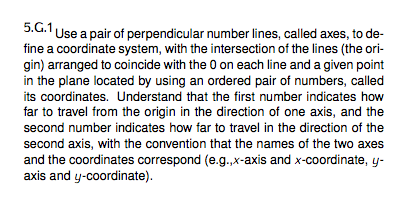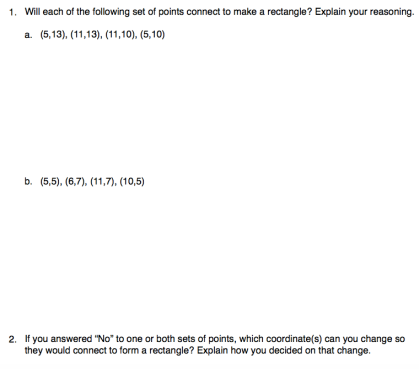This standard in 5th grade always seemed like so much of a “telling lesson” for me.

I never thought it was really addressed in the spirit of this standard in our curriculum, so I was typically like, “Here is what we call a coordinate grid. These are axes, x and y. We name the points like this…” and so on. It is not my usual approach so it always felt blah for me, for lack of a better word. I told them, they practiced plotting some points, and we played a little bit of Battleship (which was really fun).
Last week, I was planning with Leigh, a 5th grade teacher, and we spent a lot of time just talking about what we appreciate about the grid and how we can develop a sense of need in the students for it. Since they are in the middle of their 2D Geometry unit, we thought this could be the perfect place to plot points that connect to form polygons and look at patterns in the ordered pairs.
The questions we wanted to students to reason about through our intro lesson was:
- Why a coordinate grid?
- Why name a point with an ordered pair?
- Why is this helpful?
- What structure do we see?
So, we created this Desmos activity. This was our thinking on the slides and the pausing points we have planned for discussion:
Slide 1: It is really hard to describe a location without guides or landmarks.
Slide 2: Note how difficult it is. Pause and show class the results.
Slide 3: It gets easier. Still need some measurement tool. Notice the intersection of axes.
Slide 4: Note it is a bit easier this time. Pause and show class results.
Slide 5: Much easier because of the grid. Still need a starting point. See it is the distance from axes.
Slide 6: Now it is much easier. Pause show class results. Would love to show all three choices side-by-side (don’t know if this is possible in Desmos).
~Pause~ Ask, “What names of things on the grid would make it easier to talk about the point’s location?” Give students vocabulary and ask them to revisit Slide 6 to describe the location to a partner.
Slide 7: Practice writing some ordered pairs.
Slide 8: Practice writing some ordered pairs.
Slide 9: Start to see some structure in the four ordered pairs of a rectangle.
We are ending with this exit ticket (with grid paper if they choose to use it):

While we are not sure this is the best way to intro the grid, we thought it would generate some interesting conversation. Since we are teaching it tomorrow, there isn’t much time for feedback for change, but we would love your thoughts.
I think I’d include a grid in the exit ticket so they could keep making the association between symbols and grid and answer.
LikeLike
That is a good point. We were going to give them grids separate in case they wanted to plot them but we anticipated some would not need it. We wanted to see if they thought about the distance each point was from the axes in determining if it was a rectangle or not.
LikeLike
Would you include rectangles that were at funny angles?
LikeLiked by 1 person
We were thinking of just rectangles sitting horizontally or vertically, but I definitely think it would be awesome to ask them if what they notice will always be true….hoping they get at the ones that sit on funny angles!
LikeLike
(but I do love the approach!!!)
LikeLiked by 1 person
Thanks so much!
LikeLike
I really like that you are trying new things so the students feel a need (and want!) to use the coordinate grid. Not sure what prior knowledge the students are bringing to the table. Trying to put myself into student shoes, from the lesson it seems like you’re going from 0 (grids exist and allow you to be precise in defining a point’s location) to 60 (the exit ticket) real quick for one class.
LikeLike
That is kind of what I was thinking a bit too, but was curious to see what they would do. I am also a sucker for students looking for patterns in things, but that may be a bit too much here. I just can’t help myself! So, maybe the exit ticket is more them plotting the points more so then looking for patterns? Would that feel somewhere in the 30 range, rather than 60?:) They definitely have experience with the x-axis in terms of a line plot but that is about it. I am actually not sure what prior knowledge, other than that, would come before the grid exists?
LikeLike
There’s so much I don’t know about the culture of the classroom so it’s hard to say. In some classrooms I’ve seen, I would be super curious to see how they responded to the exit ticket question. In others, I would see it leading to unproductive struggle.
I do think plotting the points is about half way (although much less interesting but maybe necessary). I know you have worked with a range of students in your position so this may be preaching to the choir, but the coordinate system seems to be one of those things that’s not that complex but students struggle with through the grades (from when it’s first introduced up through high school). That’s why I’m enthused that you two are trying something new.
LikeLiked by 1 person
Thank you for sharing — I love that you are creating a need for the cartesian plane.
Even then, it might move a little fast. It emphasizes the spatial relationship of a point to the axes. I think that’s really important. It’s also important to think about how naming the point (with its x and y coordinates) helps to differentiate it from other possible points, and the potential density of points in the plane (like density on a number line).
I have used Dan Meyer’s intro in 5th before:
http://blog.mrmeyer.com/2014/pick-a-point/
I bet you could come up with a great transition from the lettered points to the coordinate grid!
Meanwhile, the exit ticket asks students to look for patterns in x and y coordinates, which feels like related (but different) thinking.
Other resources you may have seen and/or find relevant:
https://nrich.maths.org/1110
https://drive.google.com/file/d/0B_LYmkp4OJUzRG9hX3N4aDJQZ3c/view?usp=sharing
https://nrich.maths.org/6288 (Game with some interesting challenges, especially at levels 3 & 4, if you can get over the fact that it’s called Cops & Robbers.)
LikeLiked by 2 people
Hi Lindsay,
What a nice find. It asked me for a class code when I tried to go in and I was too tired to even mess around with anything. It is interesting when they talk about finding a reason to use it. I wrote myself a note the other day about using a grid to plot a dot-to-dot with some of the dots missing so they would have to find them in order to complete the picture. Also, I was wondering if you could do it like a Bingo game and the first one to line up 4 dots in a row wins (or something like that).
As I was reading this, I was thinking to myself about the Dan Meyer Ted Talk. Did his stripped down skier model have to do with coordinate planes? Didn’t he say something about it was hard to talk about skiers without assigning them some labels or something? Maybe it would be worth going in and taking a look. I would imagine he has something on plotting.
Anyhow, thanks for sharing this and if I feel a little better this afternoon, I am going to take a closer look at it. Do you have a class code? Maybe you can just get around it, I don’t know.
Brenda
LikeLiked by 1 person
Hello, I really enjoyed this post and especially the Desmos activity. Can we use this with our 5th graders? I would love to have access to it as a teacher so that I can see how they reply. Any chance you could make it available? Maybe you have and I just don’t know how to access it. I will check back later. Thanks again!
LikeLike
Thanks Kristi! Here is the teacher code for you: https://teacher.desmos.com/activitybuilder/custom/58826a1627ab6ad106f5d7ae
LikeLiked by 1 person
This wonderful! Thanks so much! I really enjoy reading your blog!!
LikeLiked by 1 person
Hi Kristin!
When I try that link to teacher.desmos.com for the activity I get an “Activity not Found” message. Can you post it one more time please! I did the student activity and really like it and would like to share it with some teachers if that’s ok!
thank you!!
LikeLike
Sorry about that Debbie – Does this one work: https://teacher.desmos.com/activitybuilder/custom/5887dcad291a74e50a578cc3
LikeLike
YES!! Thank you so much. And thank you for the very speedy reply!!
LikeLiked by 1 person
I love this activity! I remember the first time I saw Dan Meyer in his session, “If algebra is the aspirin, what was the headache?” It was all about creating the need for a mathematical structure to a situation that makes sense to the kids. First, we listed off a bunch of fruit. Then, he had us create a coordinate grid (no numbers) and the horizontal axis was on the left side difficult to eat and on the right easy to eat. Then, the veritcal axis was on the top, tasty and on the bottom not tasty. We had to put the various fruits we had listed on the coordinate grid in terms of its tastiness and ease to eat it. After that, we needed to communicate to a partner where a particular fruit was and, just like in your Desmos activity, we felt the need to create something that would help us communicate exactly where the fruit was. It was an awesome activity!
LikeLiked by 1 person
Thanks everyone for your comments! So much fun to think about all of this. I am writing it up tomorrow but I put the students’ responses in a table to show the progression in thinking from the 1st grid to the 3rd if you wanted to check that out: https://docs.google.com/document/d/10wK538NJimTfD7dWV81s408EMw5d3jlWyHKJhIl0cOI/edit?usp=sharing
LikeLike
Pingback: Following up with the Coordinate Grid | Math Minds